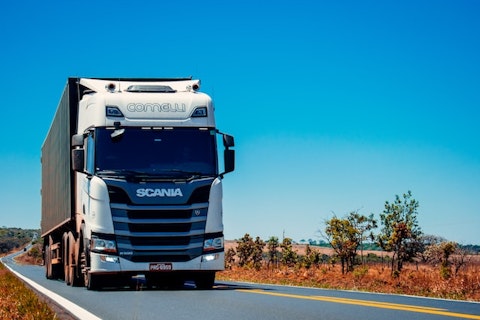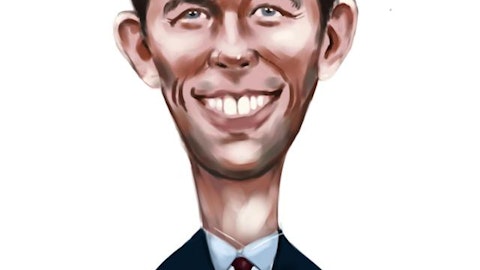Samsara Inc. (NYSE:IOT) Q4 2023 Earnings Call Transcript March 2, 2023
Mike Chang: Good afternoon and welcome to Samsara’s Fourth Quarter Fiscal 2023 Earnings Call. I am Mike Chang, Samsara’s Vice President of Corporate Development and Investor Relations. Joining me today are Samsara Co-Founder and Chief Executive Officer, Sanjit Biswas; and our Chief Financial Officer, Dominic Phillips. In addition to our prepared remarks on this call, additional information can be found in our shareholder letter, press release, investor presentation and SEC filings on our Investor Relations website at investors.samsara.com. The matters we will discuss today include forward-looking statements. Actual results may differ materially from those contained in the forward-looking statements and are subject to risks and uncertainties described more fully in our SEC filings.
Any forward-looking statements that we make on this call are based on assumptions as of today, March 2, 2023 and we undertake no obligation to update these statements as a result of new information or future events, unless required by law. During today’s call, some of our discussions will include our fourth quarter fiscal 2023 financial results. We would like to point out that the company reports non-GAAP results in addition to and not as a substitute for or superior to financial measures calculated in accordance with GAAP. All financial figures we will discuss today are non-GAAP except for revenues and revenue growth. Reconciliations of GAAP to non-GAAP financial measures are provided with our press release and investor presentation. We will make opening remarks, dive into highlights for Q4 and then open the call up for Q&A.
With that, I will hand over the call to Sanjit.
Sanjit Biswas: Thanks, Mike and thank you everyone for joining us today. FY €˜23 was a year of durable and efficient growth for Samsara and our continued momentum reflects the strength of our platform and large market opportunity ahead of us. We ended FY €˜23 with ARR of $795 million growing 42% year-over-year. During the year, we added 431 large customers with more than $100,000 of ARR, bringing us to over 1,200 large customers in total. To support customer demand, we grew our team to over 2,200 Samsarians representing approximately 40% increase in headcount year-over-year. As a company, we are focused on balancing growth and profitability and we improved our adjusted free cash flow margin year-over-year by more than 90% in Q4, with negative 3% adjusted free cash flow margin.
We also achieved Rule of 40 for the last two quarters of the fiscal year, which is a significant milestone, but there is still much work to be done to consistently achieve Rule of 40 on a quarterly and annual basis. As you know, our customers represent the broad world of physical operations and span diverse industries from food and beverage to construction to government and more. I am always impressed by the resilience of our customer base. They are the backbone of the economy and provide the critical infrastructure that keeps the world running. Many have been around for over half a century and are no strangers to challenging economic cycles. Digitization is more important than ever in today’s macroeconomic climate. Our customers are faced with difficult operating challenges and continue to search for ways to maximize the return on their investments to achieve their business goals.
In Q4, we had a milestone quarter of large deals with customers who have complex operations at scale and a breadth of assets such as cranes, tractors, vehicles and buildings. The value of the connected operations cloud is resonating with them as we digitize and combined their infrastructure into a single integrated platform. As a system of record for our customers’ daily physical operations, the amount of insights and cost savings our platform can generate is tremendous. I’d like to share a few stories about some of our large customers who are starting to use Samsara to elevate their safety programs and improve their sustainability and efficiency efforts across their vast operations. Let’s start with Nutrien Ag Solutions, our largest new ACV transaction ever.
They are one of the world’s largest agricultural agriculture inputs and services providers and the third largest nitrogen producer in the world, with roughly 75,000 assets. Nutrien adopted Samsara’s video-based safety solution to prevent accidents, promote safer driving behaviors through in-cab alerts, and help exonerate drivers from false insurance claims. Nutrien’s goal is to up-level its existing safety programs and mitigate risks through event analysis, education and training. After completing a pilot with Samsara, Nutrien saw significant improvements across driving behaviors. Let’s now turn to another exciting Q4 win. Estes Express Lines is the largest privately owned freight carrier in North America and a top 10 less-than-truckload carrier with more than 22,000 employees over 45,000 tractors and trailers and 270 terminals.
Estes expects the real-time data from Samsara’s connected operations cloud will help them increase uptime, reduce costs and achieve their goal of creating a digital twin of its entire shipment lifecycle to improve the customer experience. This way they can provide better visibility to their own customers, while removing time-intensive paper-based processes for their drivers and operations staff. Our video-based safety and vehicle telematics applications can help improve driver safety by using real-time alerts and help reduce idling. We project that a 10% to 15% reduction in idling can save them an estimated $2 million to $3 million in fuel costs annually. Additionally, we estimate that saving drivers 5 minutes per week by automating manual tasks could lead to over $1 million in annual savings.
Finally, let’s cover another Q4 deal, this time in the public sector. We added a new State Department of Transportation to an existing public sector account, which now exceeds $1 million in ARR. The state department expanded to use the connected operations cloud to better manage their light-duty and off-road assets, giving them data-driven insights to make critical operation decisions in real-time. There are almost 40 agencies within the state accounting for nearly 11,000 assets. By integrating, Samsara’s diagnostics data into its state-wide enterprise resource planning system, the state can identify which assets require immediate attention and prioritize spending across their expensive operations. They can also further their sustainability goals by benchmarking assets that use the most fuel and prioritize those best suited to transition to electric.
These customer stories represent just a snapshot of the incredible momentum we are seeing among large customers with complex operations. And we are excited to build on this in the coming year. As a system of record for physical operations, we help customers solve their toughest challenges by giving them the ability to analyze millions of data points across your expansive operations. More importantly, we help our customers achieve their business goals by transforming data into actionable insights. We have been investing in the connected operations cloud, which continues to grow and become more sophisticated, with nearly 6 trillion data points flowing in, over 50 billion API calls processed and more than 50 billion miles driven for analysis annually.
Our partner ecosystem, Samsara’s App Marketplace is also growing and now includes more than 220 integrations. Our customers are continuing to plug in additional partners and providers to fully leverage the power of our platform. On average, our largest customers are using 6 or more API integrations up from 4 API integrations just last year. I’d like to share three specific examples of how our customers across industry are seeing value and rapid ROI from unlocking their data. Let’s start with insurance premiums. Insurance premiums are consistently one of the top expenses for physical operations customers and premiums continue to rise annually. Our AI models analyze driver behaviors and road conditions in real-time provide visibility into leading causes of preventable accidents.

Photo by Gabriel Santos on Unsplash
And when a model detects one of those behaviors, we can proactively alert drivers in real-time, so they can take the appropriate action to prevent a potential accident. Safety incidents are saved to our cloud and customers and insurance providers can access this data through APIs. Insurance providers can use this data to better underwrite the risk of fleets, leading to reduced insurance premiums. Fuel prices also remain top of mind for our customers and can represent 60% of non-personnel spent. Leveraging Samsara’s fleet benchmarking solution, our customers can better understand fleet performance, identify areas for improvement, set informed goals and run their own feedback loops to ensure continuous improvements. Another important cost saving priority for our customers is extending the life of their most expensive assets from front-loaders to cranes to tractors or other costly business critical equipment.
With maintenance status data flowing through our AI models, real-time diagnostics, spot issues and proactively alert mechanics to fix vehicles before major faults take place. We are focused on creating an agile platform that meets our customer’s most pressing needs. We do this through continuous innovation powered by our data platform and customer feedback loop. A good example of this is with digital workflows and how it’s making outsized impact in transforming the worker experience. By adopting Samsara’s customizable digital workflows, our customers reduce time spent on manual written tasks freeing up valuable time for other business critical work. And we have seen tremendous traction within our platform. We have seen year-over-year improvements in the number of workflows moving daily to our system, including over 110 million driver vehicle inspection reports logged in fiscal year €˜23, a 70% increase year-over-year and over 23 million digital €“ documents digitized, a 60% increase year-over-year.
Samsara is quickly becoming the system of record for physical operations and we are excited by the vast opportunity to truly transform the worker experience for our customers. I’d like to end with the thank you to our customers, partners, investors and Samsarians for joining us on the journey to digitize physical operations. We are looking forward to another year of building the connected operations cloud. And we are excited to see many of you at beyond our customer conference and investor conference in Austin, Texas this June. I will now hand it over to Dominic to go over the financial highlights for the quarter.
Dominic Phillips: Okay. Thank you, Sanjit. As a reminder, please refer to our shareholder letter, press release and investor presentation at investors.samsara.com for additional information on our Q4 results and financial guidance. Q4 FY €˜23 was highlighted by strong top line growth and continued operating efficiency improvements. Our durable and increasingly efficient growth demonstrates the large and growing opportunity for digital transformation across the world of physical operations. While global economic uncertainty persists, we exceeded our expectations for key top line and profitability metrics for a few reasons. First, we sell into the operations budget, which is large and generally non-discretionary. Second, our customers generate hard ROI savings by deploying Samsara.
Third, our solution has a quick average payback period for customers often in months. And finally, we have a subscription business model that produces highly predictable revenue. And we price based on the number of assets versus seat-based pricing, resulting in lower risk of churn if our customers hiring slows or contracts. Our Q4 ending ARR was $795 million growing 42% year-over-year and Q4 revenue was $187 million growing 48% year-over-year. Several factors drove our strong top line performance in Q4. First, we continue to focus on serving large physical operations customers. We now have 1,237 100K plus ARR customers, a quarterly increase of 124 or 53% year-over-year. We also saw particular strength within our largest customers. We now have 51 $1 million plus ARR customers, a quarterly increase of 5% or 65% year-over-year.
Our investments in serving the largest physical operations companies in the world continue to payoff. 100K plus ARR customers represent our fastest growing cohort and make up 48% of our total ARR up from just 45% 1 year ago. And while Q4 was a strong expansion quarter, it was an even stronger new logo quarter. We added a record number of new core customers in Q4, which now total more than 19,000. New customers represented 51% of net new ACV in Q4, up from 44% in the same quarter last year and 3 of the 5 $1 million plus net new ACV deals in the quarter were new logos, including a leading traffic safety field services company operating across North America that landed with video-based safety, telematics and equipment monitoring to reduce accidents, leverage data to drive operating efficiencies, reduce fuel and maintenance costs and streamline operations.
And finally, multi-product transactions continue to significantly contribute to our top line growth. In Q4, 7 of our 10 largest transactions included subscriptions to 2 or more products. More broadly, more than 70% of core customers and more than 90% of large customers subscribe to two or more applications and 25% of core customers and more than 50% of large customers subscribe to three or more applications. In addition to delivering strong top line growth, we continue to focus on driving operating efficiency improvements across our business as we scale. As a result, we saw year-over-year leverage across all major functions. Q4 gross margin was 74%, approximately flat year-over-year and has stabilized above 70% for 10 consecutive quarters. Q4 operating margin was negative 8%, an annual improvement of more than 40% or 6 percentage points year-over-year driven by leverage across all functions.
And Q4 adjusted free cash flow margin was negative 3%, an annual improvement of more than 90% or 37 percentage points year-over-year, primarily from improved operating leverage and working capital improvements. Efficient growth continues to be a priority as demonstrated by a 45% Rule of 40 in Q4, our second consecutive Rule of 40 quarter and our highest quarter in the last 3 years. While we are pleased with this accomplishment, our goal is to continue making the necessary improvements that would allow us to achieve Rule of 40 consistently on a quarterly and annual basis. And the final Q4 point I want to make is regarding hiring and headcount. We ended FY €˜23 with more than 2,200 employees or approximately 40% growth year-over-year, adding headcount as a key input to driving future growth, but we continue to operate with discipline while making incremental investments.
Our ARR per employee at the end of FY €˜23 was more than 350,000, an all-time high and 3x higher than it was 3 years ago. Okay, now turning to guidance. As we enter our second year as a public company, we expect our guidance philosophy will be less conservative than during our first year. However, after analyzing various scenarios, we also believe it is adequately de-risked to account for the potential impact of worsening macroeconomic factors on our business. For Q1 FY €˜24, we expect total revenue to be between $190 million and $192 million representing year-over-year growth between 33% and 35%, non-GAAP operating margin to be approximately negative 15%, and non-GAAP EPS to be between negative $0.05 and negative $0.06 assuming 526 million weighted average shares outstanding.
For full year FY €˜24, we expect revenue to be between $838 million and $848 million representing year-over-year growth between 28% and 30%, non-GAAP operating margin to be approximately negative 7% and non-GAAP EPS to be between negative $0.05 and negative $0.07, assuming 536 million weighted average shares outstanding. And finally, a few additional modeling notes. First, we expect non-GAAP gross margin for FY €˜24 will be in the low-70s percent. Second, we expect to cut last year’s negative adjusted free cash flow dollars in half in FY €˜24 and we expect to reach adjusted free cash flow breakeven in Q4 this year. And finally, we expect FY €˜24 equity dilution to be between 3% and 5% and our longer term goal is annual equity dilution of less than 3%.
And please note that additional modeling notes for Q1 and FY €˜24 are included in our shareholder letter. So to wrap up, while we are operating in an uncertain macroeconomic environment, we are very pleased with our performance during our first year as a public company. We are digitizing the world of physical operations and the connected operations cloud is our customer’s system of record. We remain committed to continued operating efficiency improvements on our path to profitability and to making investments in the highest ROI areas of our business. We believe that with our markets, our platform and our focus on efficiency, we are well-positioned to continue delivering durable growth while improving profitability. With that, I will hand it over to Mike to moderate Q&A.
A – Mike Chang: Thanks, Dominic. We will now open the line for questions. When it’s your turn, please limit your questions to one main question and one follow-up question. The first question today comes from Sterling Auty at MoffettNathanson, followed by Keith Weiss at Morgan Stanley.
Sterling Auty: Can you hear me, okay?
See also 16 High Growth Non-Tech Stocks That Are Profitable and 11 High Growth UK Stocks to Buy.
Q&A Session
Follow Samsara Inc.
Follow Samsara Inc.
Mike Chang: Yes, we can hear you.
Sterling Auty: Alright. Thanks, guys. So just curious if you can characterize what sales pipelines look like exiting the quarter versus maybe 90 or 180 days ago just to help us understand the dynamics of macro impacts versus what you are doing on the sales execution side?
Sanjit Biswas: Sure. I’ll answer that. We are not seeing a lot of change to sales pipeline. I think we called out some elongated sales cycles in Q2. We saw that persist in Q3 and Q4. But we are not seeing necessarily a change in the overall pipeline or the conversion of that pipeline or the win rates, but we do continue to see customers look at longer free trials, really validating the ROI analysis, elevating decisions higher up within the organization, but we are pleased with the pipeline that we saw exiting the quarter.
Sterling Auty: Excellent. And then Dominic, you had also mentioned gross margins in the low-70s, you had a nice real sequential uptick in gross margins here in Q4. Can you remind us what are some of the dynamics that are going to ebb and flow that, that number throughout fiscal €˜24?
Sanjit Biswas: You are really not seeing a lot of leverage out of gross margin again and Q4 was approximately flat year-over-year. And even as we look into next year, most of the leverage in this business that’s going to drive better operating margins and better free cash flow margins are really going to come below gross margins. I think there is room to do some better optimizations and things like our cloud and cellular costs. We are obviously seeing some improvements in supply chain and the overall cost of hardware and that will eventually work its way through gross margins. But I just €“ I wouldn’t expect a lot more out of that as we look into FY €˜24.
Sterling Auty: Understood. Thank you.
Mike Chang: Great. Our next question comes from Keith Weiss at Morgan Stanley, followed by Matt Pfau at William Blair.
Keith Weiss: Excellent. Thank you guys so much for taking the question and really, really nice end to a strong year end. What is still a difficult environment out there? Kind of a two-part question. It does seem like the value propositions, strong ROI of the platform is coming through to customers. Are you seeing evidence of that in terms of your customer conversations in terms of pipeline conversion? And then number two, the other sort of really striking part of what we have seen throughout this year end and you guys definitely capped it off and this quarter is not just like 100K customers, but going €“ getting some of those largest potential customers out there, like the top 10 transportation companies and the like, what is it that really turned on for you guys this year? What’s working that, that’s enabling you to sort of get up to that class of customer and be so successful there?





